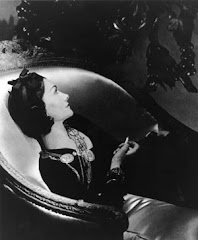What shocks me is that many of the clothes on the rail are quite grubby - some of them are even torn. Apparently these designer samples go from magazine to magazine, location to location, getting staler all the time. I can't see why fashion houses don't run up some more samples but apparently they don't, so one of the many problems of organising a shoot is that you have to book the clothes, as well as the photographer and models, and return them on the due date on pain of death.
The clothes are all size 10 but Kate Moss 'can fit anything'. Apparently she even has 'miracle feet' that can wear any shoe size. But Alex is a bit worried about her hair. 'Does she still have the fringe? I don't mind the fringe but I don't want her hair scraped back.' She also tells Phelan not to let Kate look 'too boudoir. Keep that coolness about her, not too overtly sexy.' (A couple of weeks later, I see the photos of Kate Moss in the art room and exclaim rudely, 'God, she looks awful.' She has a sort of Mia Farrow or pottery-teacher hairdo and looks dead-eyed and desiccated. The art room goes into shock until Robin Derrick the creative director murmurs, 'Of course we haven't done any retouching yet'.)
I ask Alex if Kate Moss is always a safe bet for a cover? 'Nobody's a safe bet, but a famous model helps.' One of her problems, she says, is that there are so few superstar models now. In the good old days you could take your pick of Cindy Crawford, Linda Evangelista, Helena Christensen and a dozen others but now - although there are plenty of good models who are well-respected in the fashion industry - their names mean nothing to the public. They work so hard, they don't seem to have any life outside modelling.
Read on



6 comments:
Good to know she really considers herself a journalist first. And I have to admit that as much as I love fashion mags, I’m always s bit suspect of them the same way I’m suspicious of pattern companies. A pattern company is in the business of selling patterns and I doubt they care if the patterns they sell are ever made into clothes. Similarly, a fashion mag is really in the business of selling ad space, so do they care whether the outlandishly styled layouts shows clothes are wearable in real life?
I think woman are angry over this – we want fashion to be a tool that enables us to enrich our lives – we don’t want to be on the sidelines while the industry does its own thing in a fantasy world that reflects only its own obsessions.
I found this post (and the broader article) really fascinating. I'm a Canadian who reads both American and British Vogue on a monthly basis, but I definitely prefer the UK edition - by a wide margin. In fact, I'm so irritated by the Wintour persona eclipsing everything else about US Vogue, that I'm always moments away from deciding never to read it again.
Thanks for giving me a perspective on the (down-to-earth yet pedigreed) UK editrix - about whom I haven't heard a thing till now.
I'm seeing Alex tomorrow, I'll pass that on.
I had made a typo on my earlier comment. But as I was saying, I prefer Vogue UK to Vogue US because it does not condescend to its readers or participate in ageism. It's smartly written and edited.
When I interviewed at Vogue US, I was told that I was "too intellectual" for the magazine, for fashion was "emotional." Frankly, I wouldn't want one without the other.
Miss C: How cool that you were interviewed to work at Vogue! And to have been thought too intellectual, to boot...
Have you written a post about this, by any chance? K
Post a Comment